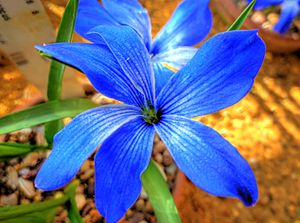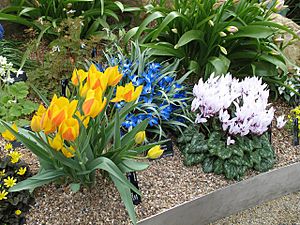Chilean blue crocus facts for kids
Quick facts for kids Chilean blue crocus |
|
|---|---|
 |
|
| Scientific classification | |
| Genus: |
Tecophilaea
|
| Species: |
cyanocrocus
|
The Tecophilaea cyanocrocus, also known as the Chilean blue crocus, is a beautiful flowering plant. It is a perennial, meaning it lives for more than two years. This plant is native to Chile, a country in South America.
You can find it growing high up in the Andes mountains. It prefers dry, stony slopes at elevations between 2,000 and 3,000 meters (about 6,500 to 9,800 feet). For a while, people thought this plant was extinct in the wild. This was due to too much collecting, animals eating too much of it, and its natural home being destroyed. Luckily, it was rediscovered in 2001!
Contents
What is the Chilean Blue Crocus?
The name cyanocrocus and its common name "Chilean blue crocus" might make you think it's a type of crocus. However, these two plants are not closely related. There isn't actually a blue crocus found in nature or grown by people.
In its natural home in Chile, the plant blooms from October to November. This is springtime in the Southern Hemisphere. If you grow it in northern countries, it usually flowers earlier, from February to March.
Tecophilaea cyanocrocus grows on short stems, up to about 10 centimeters (4 inches) tall. It has 1 to 3 long, thin, fleshy leaves. Each plant usually has a single flower. The flowers are about 2.5 centimeters (1 inch) wide and shaped like a goblet. They are a unique deep blue color with a whitish center. The root of the plant is a round, onion-like bulb called a corm, covered with fibers.
How is the Chilean Blue Crocus Classified?
The plant's genus, Tecophilaea, was named after Tecofila Billiotti. She was a botanical artist and the daughter of a botanist named Luigi Aloysius Colla. There are only two species in this group of plants. The other one is called Tecophilaea violiflora.
Originally, this genus was placed in the Amaryllidaceae family. Later, scientists decided it was different enough to have its own family. So, it became the main plant for the family called Tecophilaeaceae.
There are also several different types of Tecophilaea that people have grown. These are called cultivars. Two popular ones are 'Violacea', which has deep purple flowers, and 'Leichtlinii', which has white centers. These have been grown for many years. By mixing these and the solid blue type, new cultivars like 'Storm Cloud' have been created.
It's important not to mix up the 'Violacea' cultivar of Tecophilaea cyanocrocus with the actual species Tecophilaea violiflora. They are different!
Growing the Chilean Blue Crocus

You can grow T. cyanocrocus outdoors in places with mild winters. These are areas like USDA Zones 9-10. For example, parts of New Zealand, Ireland, and northern California have suitable climates. Here, you can plant them in outdoor rock gardens.
However, this plant doesn't like very cold weather or hard freezes. If your winters get very cold, it's best to grow them in pots. You can then move the pots to a protected spot when it's freezing. Even so, the plant is healthier if it stays outdoors during winter, as long as temperatures don't drop too far below freezing.
This plant grows best in soil that drains well. The soil should be mostly neutral, with a pH between 6 and 7. The corms (bulbs) go to sleep during the summer. Once the leaves start to fade after spring, you should stop watering completely. Unlike some other bulbs, Tecophilaea doesn't like to be baked by the sun in summer. It prefers dry, but cool, soil during this time. It's a good idea to put the pots in the shade during summer.
Start watering again when new growth appears in the fall as the soil gets cooler. In places with lots of winter rain, it's best to keep the plant out of the rain.
When the plant starts growing in the fall, you can feed it. Use a weak liquid fertilizer that is low in nitrogen. Do this once every week or two. You can also spray the leaves with fertilizer solution. This way, the fertilizer won't change the soil too much.
You can usually grow more plants from the small corms that grow off the main one. You can also get seeds by carefully hand-pollinating the flowers. However, plants grown from seeds take a very long time to flower.
The leaves of Tecophilaea are not very many. If they get damaged, the corms can become weak. So, you need to protect the plant from pests that might eat its leaves. This includes caterpillars, slugs, and deer.
Award for Garden Merit
Both Tecophilaea cyanocrocus and its 'Leichtlinii' cultivar have received an important award. They earned the Royal Horticultural Society's Award of Garden Merit. This award means they are excellent plants for gardening.
See also
Azulillo para niños (In Spanish)

